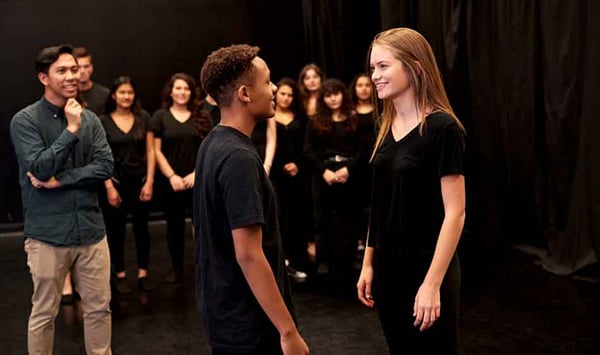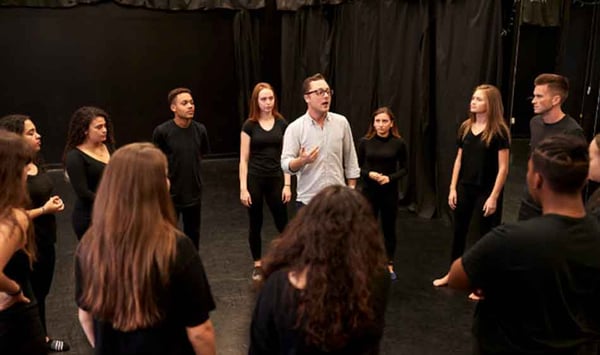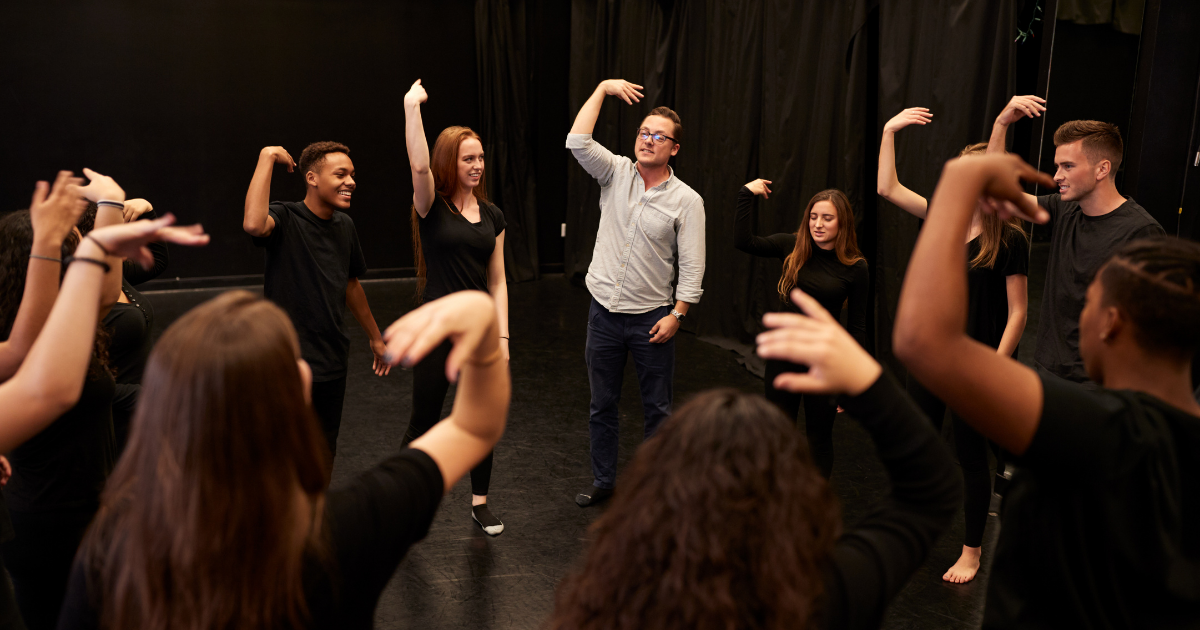8 February 2024
Devising theatre: top 5 exercises for your classroom
Devising theatre is perhaps one of the trickiest skills for a drama student to master – but also one of the most fun. It requires playfulness, a sense of adventure, intense collaboration, and a willingness to try, fail, and try again. It's also an incredibly important skill, as the majority of curriculums require students to create devised work as part of their qualification.
Here are five great devising ideas and exercises to spark creativity and imagination in your drama classroom, and get your students inspired and motivated to start creating their own work from scratch.
1. Tableaux
Extracted from Discover, Explore, Assess Packs: Teacher Notes
When working on a particular text, assign characters to students and ask them to create tableaux showing the relationships between given characters. Encourage students to use their characterisation skills, including body language and gestures, as well as consider their use of levels and proxemics. This will allow students to visualise the relationships between the different characters.
You can give students different scenarios to base their tableaux on, and question students on their positions in relation to each other. Students should be encouraged to use the character information when making decisions about their tableaux.
Next, ask students to improvise small scenes from their tableaux and encourage them to think about how these characters may speak and interact with one another. This will support students in developing their characterisation skills and allow them to consider the way an actor may perform the role.
Advanced students could work in larger groups and add in more characters to see how the image changes when new characters are added.

2. Devised Scenes
Extracted from Discover, Explore, Assess Packs: Student Workbooks
After watching a production, ask students to discuss in groups the themes and issues that are present within the play, making a list of these and choosing one theme/issue to work on.
Next, ask students to create an improvised scene based purely on that theme/issue, not on the play. They can think about a new scenario where that theme or issue might be explored by asking these questions:
- When and where does the scene take place?
- Who is involved?
- What is happening in the scene in order for the theme or issue to be explored?
Once students have performed their scenes, reflect as a class on how it was staged and what the differences and similarities were to how the theme or issue was explored in the original production.
3. Change the Scene
Extracted from A Kickstart Worksheet on Devising and Improvising
This exercise is a great way for your group to develop trust, collaborate and share in collective storytelling.
What you’ll need:
- An open space – indoors or outside
- Some random props (not essential)
- A timer
What to do:
- As a group, gather into a circle – you can be seated or standing – and set the timer for five minutes.
- A volunteer steps into the middle of the circle and begins to role-play an activity– cleaning the car, shopping for food, exercising, etc. It’s up to the person in the middle if they want to speak too.
- The rest of the group watches and looks for an opportunity to come in and add to the scene.
- Another person steps into the circle – so that there are now two people. The second person changes the scene and the first person has to go along with it.
- Continue adding people and changing the scene until all the group is involved in one big story.
- Once the whole group is in the scene, one person exits the scene by saying something that sets a new scene for the group to play.
- Once that’s established, another leaves the scene in the same way. This continues until there is only one person left in the circle in a scene of their own.
The key to this exercise is also speed, careful listening, and observation. The more you jump into the middle of the circle and allow yourself to play, the more you will discover.
Remember:
- Listen and look. This will help you change the scene.
- Support others when they change the scene.
- Let your imagination lead you.

4. Warm Up with Dialogue
Extracted from Lesson Plans: Devising
- Imagine the floor is divided up like a piece of graph paper into straight lines. Movement can only be along these lines, with any turns being sharp ones, keeping to the grid.
- Maintain a strict pace, initiated by a drum or hand clap. If some look as though they are on a collision course, evasive action must be taken, keeping to the sharp angles and lines of the grid, but the established pace and rhythm of movement must not be broken.
- Vary the speed of this so that very fast movement – but not out of control running – is interspersed with slower speeds.
- When they are used to the grid, instruct that on the next handclap they will make their way to the person nearest to them.
Give them one of the following situations, to begin a dialogue:
- Strangers meeting at a party or an important conference
- At a bus stop, where one is in a hurry and the other is laidback
- Strangers in a lift when it suddenly stops between floors
- Strangers waiting outside the crowded changing rooms to try on the same hat/dress/pair of shoes
- People who recognise each other as former school friends that they haven't seen for a while
Keep the dialogue brief – a few seconds only – before they have to go back into the grid until the next signal to stop, when again they find the nearest person – a different one if possible each time.
Extracted from Lesson Plans: Devising
Using sound to denote speech encourages physicality when starting out with characters. Consider this as a scenario:
A car driver has manoeuvred into a tight space and knocked into the bumper of another car. The driver of that car witnessed the event. Now he/she accosts the driver, as the latter leaves the car. An argument ensues. Only sounds can be used.
Explore as many of the following combinations as you can, noticing how the argument changes accordingly:
- Both people angry
- One angry, one apologetic and conciliatory
- One very unconfident, the other full of self-importance
- One in a hurry, the other meticulous, wanting all the details sorted
This exercise not only encourages experimentation but also shows how in any scenario there can be many ways of moving the scene on, led by the choice of characters.
Gobbledygook or sounds instead of words can be dipped in and out of, even when other parts of a scenario are in ordinary speech. It is another useful tool, especially when you want to underline a particularly physical or emotional moment.
Each of these activities has been extracted from a wider resource available on Digital Theatre+. To get access to the full resources, plus hundreds more engaging teaching materials and high-quality productions from award-winning companies – including devising specialists Frantic Assembly – get in touch with a member of our team today.
Related blogs
5 IB Theatre topics made easy with Digital Theatre+
Teaching IB Theatre? The International Baccalaureate in Theatre covers a vast range of theatrical...
Read more3 Ways Short Form Videos Can Help Energize Your Classroom
The average length of a video on TikTok is between 15-60 seconds, which is a far cry from the 70+...
Read moreSupporting Districts with DT+: Dr Joseph R D'Ambrosi Case Study
Dr. Joseph R. D'Ambrosi, Fine and Performing Arts Resource Specialist, shares Osceola County School...
Read moreGet the latest teaching tips straight to your inbox
Explore free lesson ideas and inspiration, education news, teaching trends and much more by signing up to regular blog updates!





